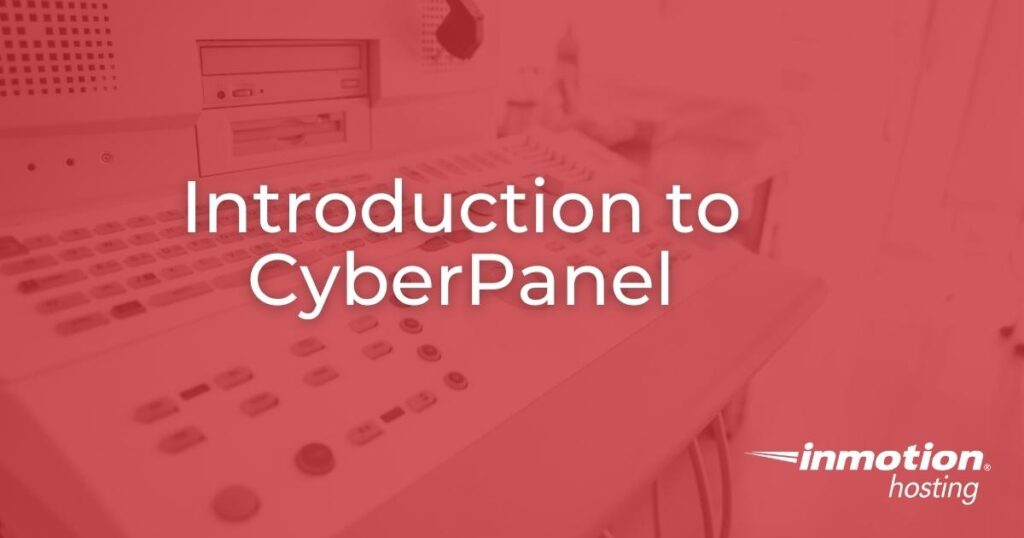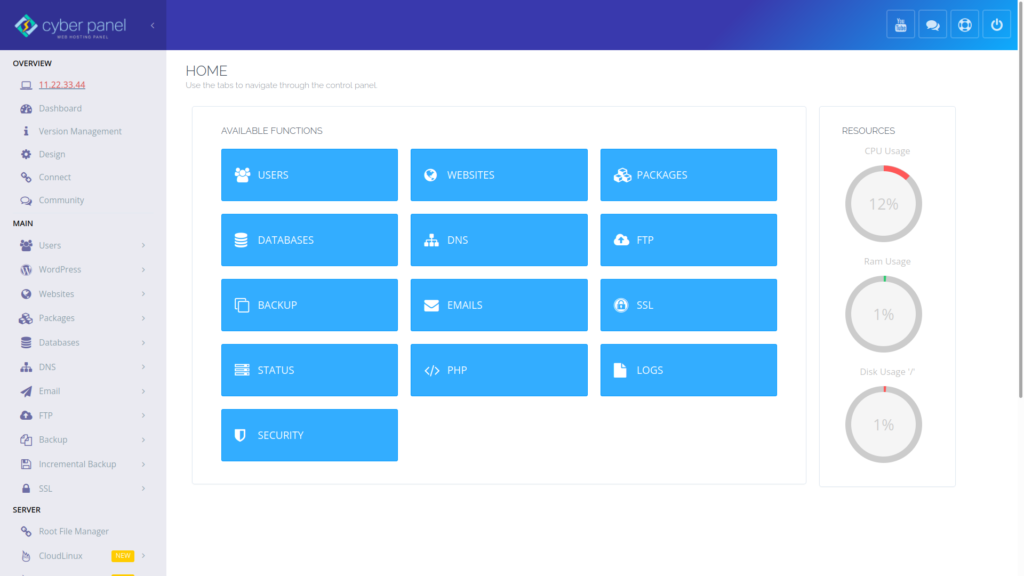
CyberPanel is an unmanaged server control panel for Ubuntu and CentOS 7.x (and 8.x) operating systems. If you prioritize website performance, this might be the server management tool for you.
What is CyberPanel?
CyberPanel is developed mostly with JavaScript and Python 3. It requires 1024MB of RAM and 10GB free disk space. Unlike other control panels we’ve covered in the past, this software runs specifically on the LiteSpeed web server (free and enterprise version), proven to be faster than Apache and NGINX.
The user interface resembles many other popular web hosting panels today. Menu options with sub-menus are nested on the left-hand sidebar, and the logout button is on the upper-right corner.

CyberPanel Features
There are various types of Linux server tasks you can accomplish from the browser-based interface.
Create user accounts with custom access control lists (ACLs) and reseller users to delegate some admin duties to other users.
Set different PHP versions for each website.
Edit DNS records for your web server without logging into your Account Management Panel (AMP).
Manage MySQL databases in your web browser with phpMyAdmin.
Upload files with the file manager or FTP server access.
Setup email with webmail access via Rainloop.
Automate full and incremental backups, store them on Google Drive, and restore data from remote locations.
Harden server security with ConfigServer Security & Firewall (CSF), ModSecurity, and ImunifyAV.
Use the app installer to quickly download WordPress, PrestaShop, Redis caching, and Elasticsearch.
Access common server logs from the web browser.
CyberPanel Add-ons
There are proprietary add-ons available for managing more data solely within the CyberPanel dashboard:
- Root File Manager
- Google Drive Backup Retention
- WordPress Manager (Staging, Backups, Plugins and Themes Management)
None of these are essential for an optimal workflow. They might be beneficial for large-scale web hosting resellers, but there are other ways to manage data, transfer backups, and administer WordPress outside of the admin dashboard.
CyberPanel Free Vs Enterprise Version
The free, open source version uses the free LiteSpeed package (OpenLiteSpeed). Meanwhile, CyberPanel Enterprise runs on LiteSpeed Web Server Enterprise and includes:
- Full Apache .htaccess support
- Server remains online during upgrade
- Edge Side Includes (ESI) markup language support
- Email and ticket support from the developers
- Multiple tiers with varying allotted domains, memory, and PHP workers allowed
The free Enterprise tier allows one domain, 2GB memory limit, and one PHP worker.
CyberPanel vs. cPanel
How does CyberPanel compare against cPanel and WebHost Manager (WHM)?
CyberPanel Free Forever:
- Free version is easy to install but has many broken features
- LiteSpeed web server is faster than Apache and NGINX
- Very few features require a premium subscription
- No cPanel migration tools
- Documentation is many times outdated
- Somewhat active community in official forum
cPanel:
- No free version
- Compatible with LiteSpeed, Apache, and NGINX
- Always receiving updates with new IT protocols
- Vast documentation due to high popularity
- Very active community in official forum
Getting Started with CyberPanel VPS
Want to give it a try? Although CyberPanel is free, we recommend you try the demo first.
- Install CyberPanel on a fresh installation of an unmanaged cloud server.
- Install WordPress, PrestaShop, or another content management system (CMS).
- Schedule server backups.
- Ensure automated snapshots are enabled in AMP.
- Learn how CyberPanel updates work.
Learn more about how to manage your CyberPanel VPS.
If you don’t need cPanel, don't pay for it. Only pay for what you need with our scalable Cloud VPS Hosting.
CentOS, Debian, or Ubuntu
No Bloatware
SSH and Root Access
